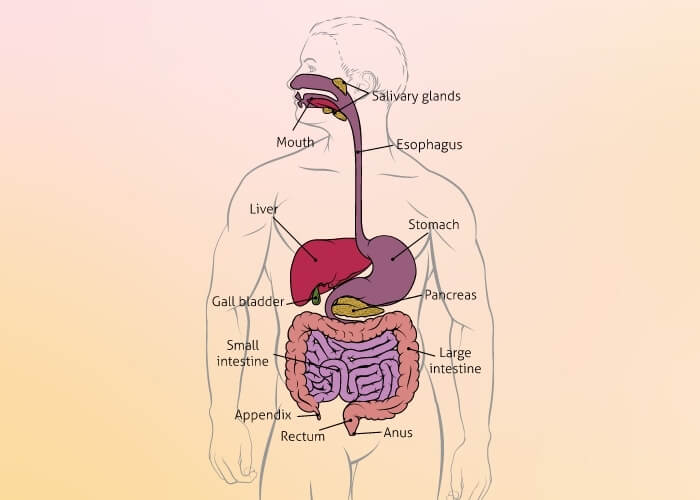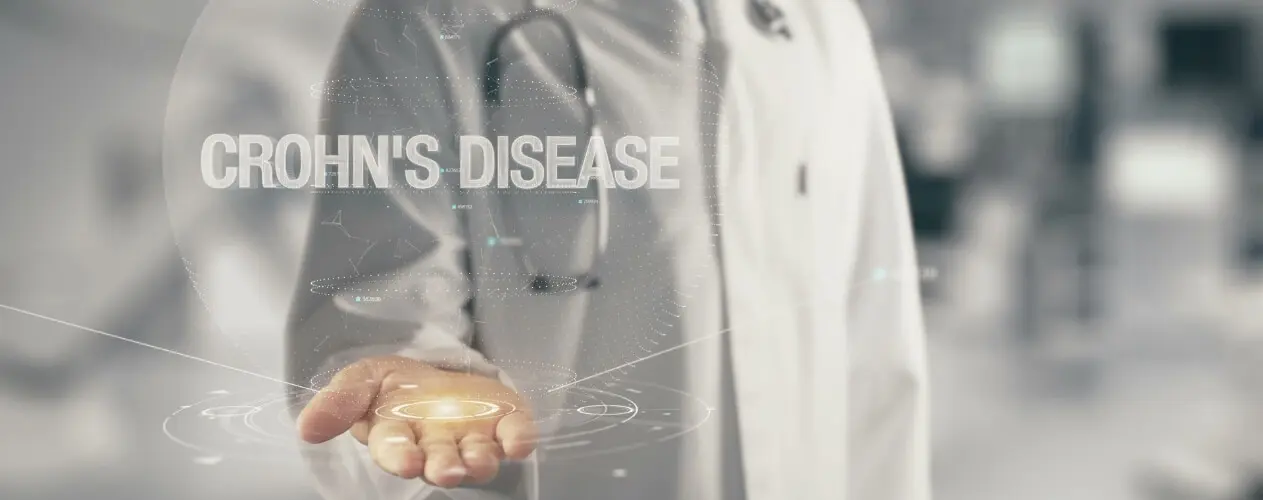Crohn’s Disease is Inflammatory Bowel Disease (IBD) with a repeating cycle of flares or active disease followed by periods of remission (when inflammation is controlled, and symptoms are absent). Crohn’s disease is an autoimmune condition, in which the immune system starts to attack healthy cells. When the immune system attacks the lining of the digestive tract, there is inflammation leading to sores (ulcers) and bleeding. Why this happens is unknown, but it is believed to be caused by immune dysfunction triggered by infection. Crohn’s disease is more common in people who have family members with the disease, indicating that heredity can play a role, too.
Crohn’s disease may involve any part of the digestive tract. In contrast to ulcerative colitis, Crohn’s inflammation involves the colon.
Symptoms vary with the involvement of different parts of the digestive tract. If you have Crohn’s disease, it is important to know which part of your digestive tract is involved, so that you can manage the condition properly. The more you know, the more you can control the symptoms. More than one type of Crohn’s disease can be seen in some people. It may skip areas, meaning there could be involvement and inflammation in the mouth and small bowel and nothing in between.
Knowing body anatomy and understanding what happens to digested food in the digestive tract will help you understand the different types of Crohn’s disease.

Human digestive system
The human body with various systems, including the digestive system, is intricate and complex. All the systems work synchronously to sustain the body functions. The gut-brain connection is one such example demonstrating the link between the brain and digestive system. The thought of eating or watching a cooking show showing a fresh-baked apple pie can release stomach juices. The connection goes both ways. A troubled gut can send signals to the brain. Similarly, the endocrine system (network of glands in your body) works in coordination with the digestive tract to digest and absorb food. The respiratory system, heart and circulatory system work together to purify the blood, supply oxygen to various organs, and remove carbon dioxide.
The human digestive system, which is 30 feet in length in adults, is a series of connected organs leading from the mouth to the anus. It is divided into 8 parts:
- Mouth
- Esophagus
- Stomach
- Small intestine (small bowel). The small intestine parts are Duodenum, Jejunum and Ileum. Duodenum connects the stomach to jejunum, and ileum is the lower end of the small intestine that connects to the large intestine.
- Large intestine (large bowel)
- Liver, pancreas and gallbladder add secretions to support digestion
- Rectum
- Anus
The food we eat passes from the mouth into the esophagus after the process of mechanically breaking down the food is completed. The process, called peristalsis (movement of organ walls), moves and pushes the food through the gastrointestinal tract. The esophagus connects the mouth to the stomach. A ring-like muscle at the end of the esophagus controls the passage of food into the stomach and controls the food from backing up into the esophagus. The stomach further breaks down the food, liquefies it, and adds digestive juices. Then the contents from the stomach are slowly released into the small intestine, where most of the digestion and absorption of nutrients takes place. The liver, pancreas, and gallbladder also aid in the digestive process by adding secretions into the small intestine. Unabsorbed materials go into the large bowel after passing through nearly 20 feet of the small bowel. The remaining liquids and electrolytes are absorbed in the large intestine before the solid material passes through the rectum and anus as feces during a bowel movement.
Involvement of the digestive tract
Crohn’s disease often causes inflammation involving the deeper layers of the digestive tract. This affects the absorption of nutrients and causes diarrhea and other symptoms.
The most common type of Crohn’s disease involves the small intestine.

5 Types of Crohn’s disease
- Ileitis
- Ileocolitis
- Crohn’s Colitis
- Perianal Disease
- Mouth or Gastroduodenal Disease
Ileocolitis
Involvement of the ileum (lower end of the small intestine) and large bowel, occurs in approximately 50% of people with Crohn’s disease. People with this type of involvement may present with abdominal pain in the middle or right lower part of the abdomen
Crohn’s colitis
This disease is limited to the colon in approximately 20% of people. In 50% of people, the rectum is spared. Because of the involvement of the colon, there may be an increased risk of colon cancer. Screening for colorectal cancer with a colonoscopy is generally done every 1-2 years with people who have had symptoms of IBD for 8 years or longer. The frequency of testing may be less than every 1-2 years, depending on the results of the previous colonoscopy.
Perianal disease
Anal involvement and/or the area around the anus is seen in a third of people.
Mouth or gastroduodenal disease
Involvement of the mouth or stomach and duodenum (an uppermost portion of the small intestine) is seen in approximately 5-15% of people. Gastroduodenal involvement may present with upper abdominal pain, nausea, and vomiting after meals.
Types of Crohn’s disease and symptoms
| Crohn’s Disease Involvement | Symptoms |
|---|---|
| Ileitis | Diarrhea, cramping, weight loss, pain in the right lower part of the abdomen |
| Ileocolitis | Diarrhea, cramping, weight loss, pain in the middle or right lower part of the abdomen |
| Crohn’s Colitis | Diarrhea, cramping, rectal bleeding, abscess, fistulas, ulcers |
| Perianal Disease | Rectal pain, perianal discharge and/or bleeding, difficulty with passing stools, perianal fistula, perianal abscess, anal fissures, anal stricture (narrowing of the anus due to scarring and inflammation) |
| Mouth or Gastroduodenal Disease | Mouth involvement may present with ulcers in the mouth and gums. Upper abdominal pain, nausea, and vomiting after meals occur with gastroduodenal involvement |
The starting point to better manage your condition is learning more about the disease affecting you. With Crohn’s disease, knowing the area of the digestive tract involved, the symptoms of the parts involved, and the different treatment approaches for your type of involvement, will all help prepare you for your future and enable you to be your own health advocate.
Your healthcare team is the best source of information for questions or concerns related to your disease involvement. Communicate openly and share all that is happening with you with your healthcare team.


